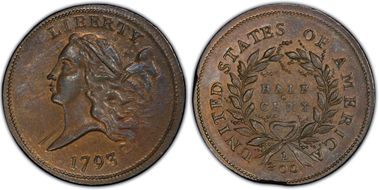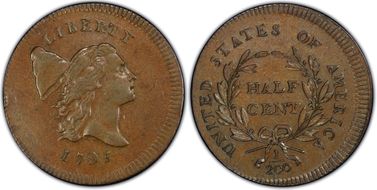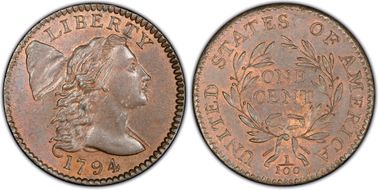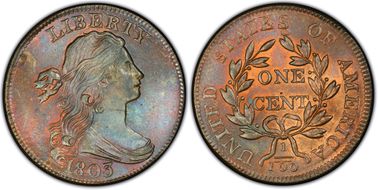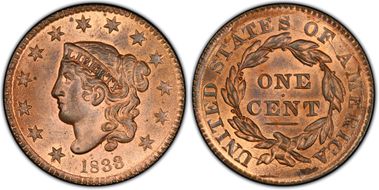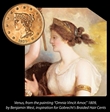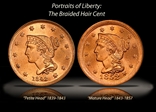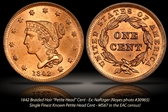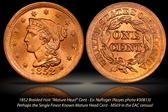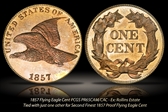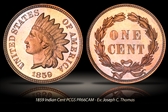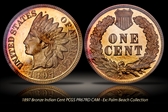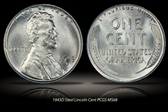cardinal 的钱币相册
The 1787 Fugio Cent is credited with being the first coin issued under the authority of the United States. Its design, following the 1776 Continental Dollar designed by Benjamin Franklin, was established by Congressional resolution on Friday, July 6, 1787 to bear on one side “thirteen circles linked together.”-----------------------------------------**The Mint Act of April 2, 1792, stated other design requirements, including the inscription “United States of America” and “an inscription which shall express the denomination of the piece, namely, cent or half cent, as the case may require.” The Mint Act made no other requirements for the reverse of one-cent pieces, so Chief Coiner Henry Voigt naturally would have assumed that the linked design of the Fugio Cent should be retained. Of course, by 1793, there were then 15 states, not 13, and so there should be 15 links to the design. As nicely as the 13 interlinked circles fit on the 40mm size of the 1776 Continental Dollar and the 29mm size of the 1787 Fugio cent, 15 linked circles would have been quite cramped on the new 27mm cent, as shown in the rendering above.---**Recognizing how cramped the design might look, Voigt might have wished to unclutter the design. By flattening the circles into oblong ovals, the fields would be opened up and the overall design simplified. Unfortunately, the resulting appearance of the Chain, quickly found public disfavor. The March 18, 1793 edition of Claypoole’s Daily Advertiser stated the opinion, “The chain on the reverse is but a bad omen for liberty.” The ill-fated chain cent design was promptly discontinued, and soon replaced by the wreath cent.-------------------------------------------------**While the chain reverse gains all the attention, the obverse of the Chain Cent is interesting in its own right. It would appear that the portrait of Liberty was either by Bob Birch, or after his design, for her eye, nose, mouth, chin and hair outline are quite similar to the Birch Cent pattern. Alas, lacking in certain of the refinements of the Birch design, she came to be called by William Sheldon as the "wild squaw with the heebie jeebies."-------------------------------------------------------------**The collection includes the famed Collins-Beckwith-Naftzger Chain Cent pedigreed all the way back to a London coin shop in 1891. This S-2 cent is the sole PCGS-MS65 the highest graded of the variety. Considered by EAC specialist Denis Loring as among the top 3 or 4 of ALL known chain cents, John Albanese (in his pre-CAC days) graded the coin fully MS66! Not surprisingly, when this coin last appeared at auction in January 2005, it set the new world record auction price for a chain cent. (That record stood for seven years until the Eliasberg Chain Cent realized an astounding $1.38 million at auction. Yet, experts consider the Cardinal Cent Cent to be quite superior to that illustrious specimen.) **
The 1787 Fugio Cent is credited with being the first coin issued under the authority of the United States. Its design, following the 1776 Continental Dollar designed by Benjamin Franklin, was established by Congressional resolution on Friday, July 6, 1787 to bear on one side “thirteen circles linked together.”-----------------------------------------**The Mint Act of April 2, 1792, stated other design requirements, including the inscription “United States of America” and “an inscription which shall express the denomination of the piece, namely, cent or half cent, as the case may require.” The Mint Act made no other requirements for the reverse of one-cent pieces, so Chief Coiner Henry Voigt naturally would have assumed that the linked design of the Fugio Cent should be retained. Of course, by 1793, there were then 15 states, not 13, and so there should be 15 links to the design. As nicely as the 13 interlinked circles fit on the 40mm size of the 1776 Continental Dollar and the 29mm size of the 1787 Fugio cent, 15 linked circles would have been quite cramped on the new 27mm cent, as shown in the rendering above.---**Recognizing how cramped the design might look, Voigt might have wished to unclutter the design. By flattening the circles into oblong ovals, the fields would be opened up and the overall design simplified. Unfortunately, the resulting appearance of the Chain, quickly found public disfavor. The March 18, 1793 edition of Claypoole’s Daily Advertiser stated the opinion, “The chain on the reverse is but a bad omen for liberty.” The ill-fated chain cent design was promptly discontinued, and soon replaced by the wreath cent.-------------------------------------------------**While the chain reverse gains all the attention, the obverse of the Chain Cent is interesting in its own right. It would appear that the portrait of Liberty was either by Bob Birch, or after his design, for her eye, nose, mouth, chin and hair outline are quite similar to the Birch Cent pattern. Alas, lacking in certain of the refinements of the Birch design, she came to be called by William Sheldon as the "wild squaw with the heebie jeebies."-------------------------------------------------------------**The collection includes the famed Collins-Beckwith-Naftzger Chain Cent pedigreed all the way back to a London coin shop in 1891. This S-2 cent is the sole PCGS-MS65 the highest graded of the variety. Considered by EAC specialist Denis Loring as among the top 3 or 4 of ALL known chain cents, John Albanese (in his pre-CAC days) graded the coin fully MS66! Not surprisingly, when this coin last appeared at auction in January 2005, it set the new world record auction price for a chain cent. (That record stood for seven years until the Eliasberg Chain Cent realized an astounding $1.38 million at auction. Yet, experts consider the Cardinal Cent Cent to be quite superior to that illustrious specimen.) **
The 1787 Fugio Cent is credited with being the first coin issued under the authority of the United States. Its design, following the 1776 Continental Dollar designed by Benjamin Franklin, was established by Congressional resolution on Friday, July 6, 1787 to bear on one side “thirteen circles linked together.”-----------------------------------------**The Mint Act of April 2, 1792, stated other design requirements, including the inscription “United States of America” and “an inscription which shall express the denomination of the piece, namely, cent or half cent, as the case may require.” The Mint Act made no other requirements for the reverse of one-cent pieces, so Chief Coiner Henry Voigt naturally would have assumed that the linked design of the Fugio Cent should be retained. Of course, by 1793, there were then 15 states, not 13, and so there should be 15 links to the design. As nicely as the 13 interlinked circles fit on the 40mm size of the 1776 Continental Dollar and the 29mm size of the 1787 Fugio cent, 15 linked circles would have been quite cramped on the new 27mm cent, as shown in the rendering above.---**Recognizing how cramped the design might look, Voigt might have wished to unclutter the design. By flattening the circles into oblong ovals, the fields would be opened up and the overall design simplified. Unfortunately, the resulting appearance of the Chain, quickly found public disfavor. The March 18, 1793 edition of Claypoole’s Daily Advertiser stated the opinion, “The chain on the reverse is but a bad omen for liberty.” The ill-fated chain cent design was promptly discontinued, and soon replaced by the wreath cent.-------------------------------------------------**While the chain reverse gains all the attention, the obverse of the Chain Cent is interesting in its own right. It would appear that the portrait of Liberty was either by Bob Birch, or after his design, for her eye, nose, mouth, chin and hair outline are quite similar to the Birch Cent pattern. Alas, lacking in certain of the refinements of the Birch design, she came to be called by William Sheldon as the "wild squaw with the heebie jeebies."-------------------------------------------------------------**The collection includes the famed Collins-Beckwith-Naftzger Chain Cent pedigreed all the way back to a London coin shop in 1891. This S-2 cent is the sole PCGS-MS65 the highest graded of the variety. Considered by EAC specialist Denis Loring as among the top 3 or 4 of ALL known chain cents, John Albanese (in his pre-CAC days) graded the coin fully MS66! Not surprisingly, when this coin last appeared at auction in January 2005, it set the new world record auction price for a chain cent. (That record stood for seven years until the Eliasberg Chain Cent realized an astounding $1.38 million at auction. Yet, experts consider the Cardinal Cent Cent to be quite superior to that illustrious specimen.) **
The 1787 Fugio Cent is credited with being the first coin issued under the authority of the United States. Its design, following the 1776 Continental Dollar designed by Benjamin Franklin, was established by Congressional resolution on Friday, July 6, 1787 to bear on one side “thirteen circles linked together.”-----------------------------------------**The Mint Act of April 2, 1792, stated other design requirements, including the inscription “United States of America” and “an inscription which shall express the denomination of the piece, namely, cent or half cent, as the case may require.” The Mint Act made no other requirements for the reverse of one-cent pieces, so Chief Coiner Henry Voigt naturally would have assumed that the linked design of the Fugio Cent should be retained. Of course, by 1793, there were then 15 states, not 13, and so there should be 15 links to the design. As nicely as the 13 interlinked circles fit on the 40mm size of the 1776 Continental Dollar and the 29mm size of the 1787 Fugio cent, 15 linked circles would have been quite cramped on the new 27mm cent, as shown in the rendering above.---**Recognizing how cramped the design might look, Voigt might have wished to unclutter the design. By flattening the circles into oblong ovals, the fields would be opened up and the overall design simplified. Unfortunately, the resulting appearance of the Chain, quickly found public disfavor. The March 18, 1793 edition of Claypoole’s Daily Advertiser stated the opinion, “The chain on the reverse is but a bad omen for liberty.” The ill-fated chain cent design was promptly discontinued, and soon replaced by the wreath cent.-------------------------------------------------**While the chain reverse gains all the attention, the obverse of the Chain Cent is interesting in its own right. It would appear that the portrait of Liberty was either by Bob Birch, or after his design, for her eye, nose, mouth, chin and hair outline are quite similar to the Birch Cent pattern. Alas, lacking in certain of the refinements of the Birch design, she came to be called by William Sheldon as the "wild squaw with the heebie jeebies."-------------------------------------------------------------**The collection includes the famed Collins-Beckwith-Naftzger Chain Cent pedigreed all the way back to a London coin shop in 1891. This S-2 cent is the sole PCGS-MS65 the highest graded of the variety. Considered by EAC specialist Denis Loring as among the top 3 or 4 of ALL known chain cents, John Albanese (in his pre-CAC days) graded the coin fully MS66! Not surprisingly, when this coin last appeared at auction in January 2005, it set the new world record auction price for a chain cent. (That record stood for seven years until the Eliasberg Chain Cent realized an astounding $1.38 million at auction. Yet, experts consider the Cardinal Cent Cent to be quite superior to that illustrious specimen.) **
The 1787 Fugio Cent is credited with being the first coin issued under the authority of the United States. Its design, following the 1776 Continental Dollar designed by Benjamin Franklin, was established by Congressional resolution on Friday, July 6, 1787 to bear on one side “thirteen circles linked together.”-----------------------------------------**The Mint Act of April 2, 1792, stated other design requirements, including the inscription “United States of America” and “an inscription which shall express the denomination of the piece, namely, cent or half cent, as the case may require.” The Mint Act made no other requirements for the reverse of one-cent pieces, so Chief Coiner Henry Voigt naturally would have assumed that the linked design of the Fugio Cent should be retained. Of course, by 1793, there were then 15 states, not 13, and so there should be 15 links to the design. As nicely as the 13 interlinked circles fit on the 40mm size of the 1776 Continental Dollar and the 29mm size of the 1787 Fugio cent, 15 linked circles would have been quite cramped on the new 27mm cent, as shown in the rendering above.---**Recognizing how cramped the design might look, Voigt might have wished to unclutter the design. By flattening the circles into oblong ovals, the fields would be opened up and the overall design simplified. Unfortunately, the resulting appearance of the Chain, quickly found public disfavor. The March 18, 1793 edition of Claypoole’s Daily Advertiser stated the opinion, “The chain on the reverse is but a bad omen for liberty.” The ill-fated chain cent design was promptly discontinued, and soon replaced by the wreath cent.-------------------------------------------------**While the chain reverse gains all the attention, the obverse of the Chain Cent is interesting in its own right. It would appear that the portrait of Liberty was either by Bob Birch, or after his design, for her eye, nose, mouth, chin and hair outline are quite similar to the Birch Cent pattern. Alas, lacking in certain of the refinements of the Birch design, she came to be called by William Sheldon as the "wild squaw with the heebie jeebies."-------------------------------------------------------------**The collection includes the famed Collins-Beckwith-Naftzger Chain Cent pedigreed all the way back to a London coin shop in 1891. This S-2 cent is the sole PCGS-MS65 the highest graded of the variety. Considered by EAC specialist Denis Loring as among the top 3 or 4 of ALL known chain cents, John Albanese (in his pre-CAC days) graded the coin fully MS66! Not surprisingly, when this coin last appeared at auction in January 2005, it set the new world record auction price for a chain cent. (That record stood for seven years until the Eliasberg Chain Cent realized an astounding $1.38 million at auction. Yet, experts consider the Cardinal Cent Cent to be quite superior to that illustrious specimen.) **
As with the Chain Cent before it, the Wreath Cent derives its common name from its reverse design, in this case bearing an exceptionally ornate wreath of leaves and berries, unlike any other wreath to appear on any other circulating one-cent piece. Clearly the design was created by Bob Birch, or by someone following his design, for its structure is strikingly similar to that of the Birch Cent pattern, particularly in the elongated strings of berries.-------------------------------------------------------------------------------**Indeed, the reverse of the Wreath Cent is completely different from the Chain Cent, but the obverse portrait of Liberty is completely different as well, remodeled based on Joseph Wright's Libertas Americana medal. Here we see a portion of the self-painted portrait of Joseph Wright's family, isolating his lovely wife Sarah. Through an introduction by his mother, Joseph was visiting with Benjamin Franklin in Paris during the time of the creation of the Libertas Americana medals. No doubt, the final engraving of the medal dies themselves was by the hand of French artist Augustin Dupre. However, the stark similarities among Joseph's portrait of Sarah, the portrait of Liberty gracing the Libertas Americana medal, and the portrait of Liberty seen on the 1793 Liberty Cap half cents attributed to Wright, are all undeniable and reflect on Wright as their creator.-------**Franklin was sufficiently impressed with Wright that through Franklin's connections with diplomat John Jay and Secretary of Foreign Affairs Robert Livingston, he arranged for Wright to be introduced to George Washington, and then later appointed by Washington as a draftsman and die sinker for the Mint. Among Wright's first creations at the mint was the 1792 Disme pattern seen here, which clearly draws off of the Libertas Americana design.-----------------------------**Comparing the Disme pattern with the Wreath Cent, we see the clear similarities of the designs. Liberty's profile and the styling of her flowing locks amply reflect Wright's artistic hand. The public still did not like the design, however, finding Miss Liberty to be "too unkempt" for polite society. The Wreath Cent was soon discontinued, to be replaced by Wright's Liberty Cap design.------------**The collection includes a truly superb specimen of the Wreath Cent from the Naftzger Collection. The absolute Pop Top at MS69, this is not only the single highest graded Wreath Cent, it is the single highest graded 18th century coin, period! The strike is truly fantastic and pinpoint sharp, clearly showing the individual strands of Miss Liberty's flowing hair and complete veins on all of the leaves -- including those above the date on the obverse. Of course, the surfaces are also phenomenal and near total perfection, so much so that even the fastidiously conservative EAC condition census recognizes this piece as the finest "all brown" Wreath Cent.
As with the Chain Cent before it, the Wreath Cent derives its common name from its reverse design, in this case bearing an exceptionally ornate wreath of leaves and berries, unlike any other wreath to appear on any other circulating one-cent piece. Clearly the design was created by Bob Birch, or by someone following his design, for its structure is strikingly similar to that of the Birch Cent pattern, particularly in the elongated strings of berries.-------------------------------------------------------------------------------**Indeed, the reverse of the Wreath Cent is completely different from the Chain Cent, but the obverse portrait of Liberty is completely different as well, remodeled based on Joseph Wright's Libertas Americana medal. Here we see a portion of the self-painted portrait of Joseph Wright's family, isolating his lovely wife Sarah. Through an introduction by his mother, Joseph was visiting with Benjamin Franklin in Paris during the time of the creation of the Libertas Americana medals. No doubt, the final engraving of the medal dies themselves was by the hand of French artist Augustin Dupre. However, the stark similarities among Joseph's portrait of Sarah, the portrait of Liberty gracing the Libertas Americana medal, and the portrait of Liberty seen on the 1793 Liberty Cap half cents attributed to Wright, are all undeniable and reflect on Wright as their creator.-------**Franklin was sufficiently impressed with Wright that through Franklin's connections with diplomat John Jay and Secretary of Foreign Affairs Robert Livingston, he arranged for Wright to be introduced to George Washington, and then later appointed by Washington as a draftsman and die sinker for the Mint. Among Wright's first creations at the mint was the 1792 Disme pattern seen here, which clearly draws off of the Libertas Americana design.-----------------------------**Comparing the Disme pattern with the Wreath Cent, we see the clear similarities of the designs. Liberty's profile and the styling of her flowing locks amply reflect Wright's artistic hand. The public still did not like the design, however, finding Miss Liberty to be "too unkempt" for polite society. The Wreath Cent was soon discontinued, to be replaced by Wright's Liberty Cap design.------------**The collection includes a truly superb specimen of the Wreath Cent from the Naftzger Collection. The absolute Pop Top at MS69, this is not only the single highest graded Wreath Cent, it is the single highest graded 18th century coin, period! The strike is truly fantastic and pinpoint sharp, clearly showing the individual strands of Miss Liberty's flowing hair and complete veins on all of the leaves -- including those above the date on the obverse. Of course, the surfaces are also phenomenal and near total perfection, so much so that even the fastidiously conservative EAC condition census recognizes this piece as the finest "all brown" Wreath Cent.
As with the Chain Cent before it, the Wreath Cent derives its common name from its reverse design, in this case bearing an exceptionally ornate wreath of leaves and berries, unlike any other wreath to appear on any other circulating one-cent piece. Clearly the design was created by Bob Birch, or by someone following his design, for its structure is strikingly similar to that of the Birch Cent pattern, particularly in the elongated strings of berries.-------------------------------------------------------------------------------**Indeed, the reverse of the Wreath Cent is completely different from the Chain Cent, but the obverse portrait of Liberty is completely different as well, remodeled based on Joseph Wright's Libertas Americana medal. Here we see a portion of the self-painted portrait of Joseph Wright's family, isolating his lovely wife Sarah. Through an introduction by his mother, Joseph was visiting with Benjamin Franklin in Paris during the time of the creation of the Libertas Americana medals. No doubt, the final engraving of the medal dies themselves was by the hand of French artist Augustin Dupre. However, the stark similarities among Joseph's portrait of Sarah, the portrait of Liberty gracing the Libertas Americana medal, and the portrait of Liberty seen on the 1793 Liberty Cap half cents attributed to Wright, are all undeniable and reflect on Wright as their creator.-------**Franklin was sufficiently impressed with Wright that through Franklin's connections with diplomat John Jay and Secretary of Foreign Affairs Robert Livingston, he arranged for Wright to be introduced to George Washington, and then later appointed by Washington as a draftsman and die sinker for the Mint. Among Wright's first creations at the mint was the 1792 Disme pattern seen here, which clearly draws off of the Libertas Americana design.-----------------------------**Comparing the Disme pattern with the Wreath Cent, we see the clear similarities of the designs. Liberty's profile and the styling of her flowing locks amply reflect Wright's artistic hand. The public still did not like the design, however, finding Miss Liberty to be "too unkempt" for polite society. The Wreath Cent was soon discontinued, to be replaced by Wright's Liberty Cap design.------------**The collection includes a truly superb specimen of the Wreath Cent from the Naftzger Collection. The absolute Pop Top at MS69, this is not only the single highest graded Wreath Cent, it is the single highest graded 18th century coin, period! The strike is truly fantastic and pinpoint sharp, clearly showing the individual strands of Miss Liberty's flowing hair and complete veins on all of the leaves -- including those above the date on the obverse. Of course, the surfaces are also phenomenal and near total perfection, so much so that even the fastidiously conservative EAC condition census recognizes this piece as the finest "all brown" Wreath Cent.
As with the Chain Cent before it, the Wreath Cent derives its common name from its reverse design, in this case bearing an exceptionally ornate wreath of leaves and berries, unlike any other wreath to appear on any other circulating one-cent piece. Clearly the design was created by Bob Birch, or by someone following his design, for its structure is strikingly similar to that of the Birch Cent pattern, particularly in the elongated strings of berries.-------------------------------------------------------------------------------**Indeed, the reverse of the Wreath Cent is completely different from the Chain Cent, but the obverse portrait of Liberty is completely different as well, remodeled based on Joseph Wright's Libertas Americana medal. Here we see a portion of the self-painted portrait of Joseph Wright's family, isolating his lovely wife Sarah. Through an introduction by his mother, Joseph was visiting with Benjamin Franklin in Paris during the time of the creation of the Libertas Americana medals. No doubt, the final engraving of the medal dies themselves was by the hand of French artist Augustin Dupre. However, the stark similarities among Joseph's portrait of Sarah, the portrait of Liberty gracing the Libertas Americana medal, and the portrait of Liberty seen on the 1793 Liberty Cap half cents attributed to Wright, are all undeniable and reflect on Wright as their creator.-------**Franklin was sufficiently impressed with Wright that through Franklin's connections with diplomat John Jay and Secretary of Foreign Affairs Robert Livingston, he arranged for Wright to be introduced to George Washington, and then later appointed by Washington as a draftsman and die sinker for the Mint. Among Wright's first creations at the mint was the 1792 Disme pattern seen here, which clearly draws off of the Libertas Americana design.-----------------------------**Comparing the Disme pattern with the Wreath Cent, we see the clear similarities of the designs. Liberty's profile and the styling of her flowing locks amply reflect Wright's artistic hand. The public still did not like the design, however, finding Miss Liberty to be "too unkempt" for polite society. The Wreath Cent was soon discontinued, to be replaced by Wright's Liberty Cap design.------------**The collection includes a truly superb specimen of the Wreath Cent from the Naftzger Collection. The absolute Pop Top at MS69, this is not only the single highest graded Wreath Cent, it is the single highest graded 18th century coin, period! The strike is truly fantastic and pinpoint sharp, clearly showing the individual strands of Miss Liberty's flowing hair and complete veins on all of the leaves -- including those above the date on the obverse. Of course, the surfaces are also phenomenal and near total perfection, so much so that even the fastidiously conservative EAC condition census recognizes this piece as the finest "all brown" Wreath Cent.
As with the Chain Cent before it, the Wreath Cent derives its common name from its reverse design, in this case bearing an exceptionally ornate wreath of leaves and berries, unlike any other wreath to appear on any other circulating one-cent piece. Clearly the design was created by Bob Birch, or by someone following his design, for its structure is strikingly similar to that of the Birch Cent pattern, particularly in the elongated strings of berries.-------------------------------------------------------------------------------**Indeed, the reverse of the Wreath Cent is completely different from the Chain Cent, but the obverse portrait of Liberty is completely different as well, remodeled based on Joseph Wright's Libertas Americana medal. Here we see a portion of the self-painted portrait of Joseph Wright's family, isolating his lovely wife Sarah. Through an introduction by his mother, Joseph was visiting with Benjamin Franklin in Paris during the time of the creation of the Libertas Americana medals. No doubt, the final engraving of the medal dies themselves was by the hand of French artist Augustin Dupre. However, the stark similarities among Joseph's portrait of Sarah, the portrait of Liberty gracing the Libertas Americana medal, and the portrait of Liberty seen on the 1793 Liberty Cap half cents attributed to Wright, are all undeniable and reflect on Wright as their creator.-------**Franklin was sufficiently impressed with Wright that through Franklin's connections with diplomat John Jay and Secretary of Foreign Affairs Robert Livingston, he arranged for Wright to be introduced to George Washington, and then later appointed by Washington as a draftsman and die sinker for the Mint. Among Wright's first creations at the mint was the 1792 Disme pattern seen here, which clearly draws off of the Libertas Americana design.-----------------------------**Comparing the Disme pattern with the Wreath Cent, we see the clear similarities of the designs. Liberty's profile and the styling of her flowing locks amply reflect Wright's artistic hand. The public still did not like the design, however, finding Miss Liberty to be "too unkempt" for polite society. The Wreath Cent was soon discontinued, to be replaced by Wright's Liberty Cap design.------------**The collection includes a truly superb specimen of the Wreath Cent from the Naftzger Collection. The absolute Pop Top at MS69, this is not only the single highest graded Wreath Cent, it is the single highest graded 18th century coin, period! The strike is truly fantastic and pinpoint sharp, clearly showing the individual strands of Miss Liberty's flowing hair and complete veins on all of the leaves -- including those above the date on the obverse. Of course, the surfaces are also phenomenal and near total perfection, so much so that even the fastidiously conservative EAC condition census recognizes this piece as the finest "all brown" Wreath Cent.
The very first of the Liberty Cap cents were designed by Joseph Wright. Undoubtedly, his inspiration came from his own mother Patience Wright, herself a world-renowned artist of the time, and her modeling for the sketch "The Personification of Liberty" in 1777. Sadly, Joseph Wright succumbed to the outbreak of yellow fever in Philadelphia in 1793, and his cent designs were employed only in 1793 and shortly afterward.------**For 1794, the Liberty Cap cents are seen with one of three very distinctive portraits of Miss Liberty, each resulting from the work of different artists, and the collection contains superb examples of all three:---------------------------------------------------------------------------------------**First up is the "Head of '93" subtype designed by Joseph Wright, as seen here in the MS64BN Garrett S-18b cent, the single finest known specimen of the subtype, which depicts Liberty in high, rounded relief with simple tresses to her hair.------------------------------------------------------------**Next is the "Head of '94" subtype designed by Robert Scot, as seen here in the incredible MS66RB specimen of the S-26 variety from the Eliasberg Collection, which displays Liberty in an intricately sculptured high relief with chiseled features and finely detailed hair. With immaculate surfaces and sparkling cartwheel luster, this coin not only places high in the census for the date, it is one of just 7 MS66RB coins graded by PCGS for the entire series, and there are just two specimens in MS67RB.------------------------------------------------------------------------------------------------**Finally, the "Head of '95" subtype designed by John Smith Gardner shows Miss Liberty completely re-modeled and rendered in lower relief. It is represented here by the incredible coin acknowledged by the EAC as the single finest known specimen of the S-67 variety, which traces its provenance to Lord St. Oswald, William H. Sheldon, R.E. Naftzger and Walter Husak. This coin displays unbelievable surfaces, beaming with stunning cartwheel luster and abundant mint red throughout. Appearing at the top of the EAC census as MS68, this coin is not only the single finest known S-67 specimen, it is also acknowledged as the single finest remaining 1794 cent of ANY variety, and it is the ONLY 1794 "Head of 1795" cent to be graded by PCGS as MS67RB!
The very first of the Liberty Cap cents were designed by Joseph Wright. Undoubtedly, his inspiration came from his own mother Patience Wright, herself a world-renowned artist of the time, and her modeling for the sketch "The Personification of Liberty" in 1777. Sadly, Joseph Wright succumbed to the outbreak of yellow fever in Philadelphia in 1793, and his cent designs were employed only in 1793 and shortly afterward.------**For 1794, the Liberty Cap cents are seen with one of three very distinctive portraits of Miss Liberty, each resulting from the work of different artists, and the collection contains superb examples of all three:---------------------------------------------------------------------------------------**First up is the "Head of '93" subtype designed by Joseph Wright, as seen here in the MS64BN Garrett S-18b cent, the single finest known specimen of the subtype, which depicts Liberty in high, rounded relief with simple tresses to her hair.------------------------------------------------------------**Next is the "Head of '94" subtype designed by Robert Scot, as seen here in the incredible MS66RB specimen of the S-26 variety from the Eliasberg Collection, which displays Liberty in an intricately sculptured high relief with chiseled features and finely detailed hair. With immaculate surfaces and sparkling cartwheel luster, this coin not only places high in the census for the date, it is one of just 7 MS66RB coins graded by PCGS for the entire series, and there are just two specimens in MS67RB.------------------------------------------------------------------------------------------------**Finally, the "Head of '95" subtype designed by John Smith Gardner shows Miss Liberty completely re-modeled and rendered in lower relief. It is represented here by the incredible coin acknowledged by the EAC as the single finest known specimen of the S-67 variety, which traces its provenance to Lord St. Oswald, William H. Sheldon, R.E. Naftzger and Walter Husak. This coin displays unbelievable surfaces, beaming with stunning cartwheel luster and abundant mint red throughout. Appearing at the top of the EAC census as MS68, this coin is not only the single finest known S-67 specimen, it is also acknowledged as the single finest remaining 1794 cent of ANY variety, and it is the ONLY 1794 "Head of 1795" cent to be graded by PCGS as MS67RB!
The very first of the Liberty Cap cents were designed by Joseph Wright. Undoubtedly, his inspiration came from his own mother Patience Wright, herself a world-renowned artist of the time, and her modeling for the sketch "The Personification of Liberty" in 1777. Sadly, Joseph Wright succumbed to the outbreak of yellow fever in Philadelphia in 1793, and his cent designs were employed only in 1793 and shortly afterward.------**For 1794, the Liberty Cap cents are seen with one of three very distinctive portraits of Miss Liberty, each resulting from the work of different artists, and the collection contains superb examples of all three:---------------------------------------------------------------------------------------**First up is the "Head of '93" subtype designed by Joseph Wright, as seen here in the MS64BN Garrett S-18b cent, the single finest known specimen of the subtype, which depicts Liberty in high, rounded relief with simple tresses to her hair.------------------------------------------------------------**Next is the "Head of '94" subtype designed by Robert Scot, as seen here in the incredible MS66RB specimen of the S-26 variety from the Eliasberg Collection, which displays Liberty in an intricately sculptured high relief with chiseled features and finely detailed hair. With immaculate surfaces and sparkling cartwheel luster, this coin not only places high in the census for the date, it is one of just 7 MS66RB coins graded by PCGS for the entire series, and there are just two specimens in MS67RB.------------------------------------------------------------------------------------------------**Finally, the "Head of '95" subtype designed by John Smith Gardner shows Miss Liberty completely re-modeled and rendered in lower relief. It is represented here by the incredible coin acknowledged by the EAC as the single finest known specimen of the S-67 variety, which traces its provenance to Lord St. Oswald, William H. Sheldon, R.E. Naftzger and Walter Husak. This coin displays unbelievable surfaces, beaming with stunning cartwheel luster and abundant mint red throughout. Appearing at the top of the EAC census as MS68, this coin is not only the single finest known S-67 specimen, it is also acknowledged as the single finest remaining 1794 cent of ANY variety, and it is the ONLY 1794 "Head of 1795" cent to be graded by PCGS as MS67RB!
The very first of the Liberty Cap cents were designed by Joseph Wright. Undoubtedly, his inspiration came from his own mother Patience Wright, herself a world-renowned artist of the time, and her modeling for the sketch "The Personification of Liberty" in 1777. Sadly, Joseph Wright succumbed to the outbreak of yellow fever in Philadelphia in 1793, and his cent designs were employed only in 1793 and shortly afterward.------**For 1794, the Liberty Cap cents are seen with one of three very distinctive portraits of Miss Liberty, each resulting from the work of different artists, and the collection contains superb examples of all three:---------------------------------------------------------------------------------------**First up is the "Head of '93" subtype designed by Joseph Wright, as seen here in the MS64BN Garrett S-18b cent, the single finest known specimen of the subtype, which depicts Liberty in high, rounded relief with simple tresses to her hair.------------------------------------------------------------**Next is the "Head of '94" subtype designed by Robert Scot, as seen here in the incredible MS66RB specimen of the S-26 variety from the Eliasberg Collection, which displays Liberty in an intricately sculptured high relief with chiseled features and finely detailed hair. With immaculate surfaces and sparkling cartwheel luster, this coin not only places high in the census for the date, it is one of just 7 MS66RB coins graded by PCGS for the entire series, and there are just two specimens in MS67RB.------------------------------------------------------------------------------------------------**Finally, the "Head of '95" subtype designed by John Smith Gardner shows Miss Liberty completely re-modeled and rendered in lower relief. It is represented here by the incredible coin acknowledged by the EAC as the single finest known specimen of the S-67 variety, which traces its provenance to Lord St. Oswald, William H. Sheldon, R.E. Naftzger and Walter Husak. This coin displays unbelievable surfaces, beaming with stunning cartwheel luster and abundant mint red throughout. Appearing at the top of the EAC census as MS68, this coin is not only the single finest known S-67 specimen, it is also acknowledged as the single finest remaining 1794 cent of ANY variety, and it is the ONLY 1794 "Head of 1795" cent to be graded by PCGS as MS67RB!
The very first of the Liberty Cap cents were designed by Joseph Wright. Undoubtedly, his inspiration came from his own mother Patience Wright, herself a world-renowned artist of the time, and her modeling for the sketch "The Personification of Liberty" in 1777. Sadly, Joseph Wright succumbed to the outbreak of yellow fever in Philadelphia in 1793, and his cent designs were employed only in 1793 and shortly afterward.------**For 1794, the Liberty Cap cents are seen with one of three very distinctive portraits of Miss Liberty, each resulting from the work of different artists, and the collection contains superb examples of all three:---------------------------------------------------------------------------------------**First up is the "Head of '93" subtype designed by Joseph Wright, as seen here in the MS64BN Garrett S-18b cent, the single finest known specimen of the subtype, which depicts Liberty in high, rounded relief with simple tresses to her hair.------------------------------------------------------------**Next is the "Head of '94" subtype designed by Robert Scot, as seen here in the incredible MS66RB specimen of the S-26 variety from the Eliasberg Collection, which displays Liberty in an intricately sculptured high relief with chiseled features and finely detailed hair. With immaculate surfaces and sparkling cartwheel luster, this coin not only places high in the census for the date, it is one of just 7 MS66RB coins graded by PCGS for the entire series, and there are just two specimens in MS67RB.------------------------------------------------------------------------------------------------**Finally, the "Head of '95" subtype designed by John Smith Gardner shows Miss Liberty completely re-modeled and rendered in lower relief. It is represented here by the incredible coin acknowledged by the EAC as the single finest known specimen of the S-67 variety, which traces its provenance to Lord St. Oswald, William H. Sheldon, R.E. Naftzger and Walter Husak. This coin displays unbelievable surfaces, beaming with stunning cartwheel luster and abundant mint red throughout. Appearing at the top of the EAC census as MS68, this coin is not only the single finest known S-67 specimen, it is also acknowledged as the single finest remaining 1794 cent of ANY variety, and it is the ONLY 1794 "Head of 1795" cent to be graded by PCGS as MS67RB!
The very first of the Liberty Cap cents were designed by Joseph Wright. Undoubtedly, his inspiration came from his own mother Patience Wright, herself a world-renowned artist of the time, and her modeling for the sketch "The Personification of Liberty" in 1777. Sadly, Joseph Wright succumbed to the outbreak of yellow fever in Philadelphia in 1793, and his cent designs were employed only in 1793 and shortly afterward.------**For 1794, the Liberty Cap cents are seen with one of three very distinctive portraits of Miss Liberty, each resulting from the work of different artists, and the collection contains superb examples of all three:---------------------------------------------------------------------------------------**First up is the "Head of '93" subtype designed by Joseph Wright, as seen here in the MS64BN Garrett S-18b cent, the single finest known specimen of the subtype, which depicts Liberty in high, rounded relief with simple tresses to her hair.------------------------------------------------------------**Next is the "Head of '94" subtype designed by Robert Scot, as seen here in the incredible MS66RB specimen of the S-26 variety from the Eliasberg Collection, which displays Liberty in an intricately sculptured high relief with chiseled features and finely detailed hair. With immaculate surfaces and sparkling cartwheel luster, this coin not only places high in the census for the date, it is one of just 7 MS66RB coins graded by PCGS for the entire series, and there are just two specimens in MS67RB.------------------------------------------------------------------------------------------------**Finally, the "Head of '95" subtype designed by John Smith Gardner shows Miss Liberty completely re-modeled and rendered in lower relief. It is represented here by the incredible coin acknowledged by the EAC as the single finest known specimen of the S-67 variety, which traces its provenance to Lord St. Oswald, William H. Sheldon, R.E. Naftzger and Walter Husak. This coin displays unbelievable surfaces, beaming with stunning cartwheel luster and abundant mint red throughout. Appearing at the top of the EAC census as MS68, this coin is not only the single finest known S-67 specimen, it is also acknowledged as the single finest remaining 1794 cent of ANY variety, and it is the ONLY 1794 "Head of 1795" cent to be graded by PCGS as MS67RB!
1803 S-243 cent from the Naftzger collection, PCGS graded Ms-66RB. Among the top 3 finest of ALL Draped Bust cents in the official EAC condition census, this coin was so prized by Ted Naftzger he held it back from the 1973 and 1992 sales of the majority of his collection, and kept it for the rest of his life. With one look, anyone can see why Ted was so captivated by this piece. Displaying magnificent color and mind blowing cartwheel luster, this coin is not only graded fully MS67 by the conservative EAC standards, but deemed "choice" for that lofty grade! Of the 216 die varieties of Draped Bust cents comprising the 16+ million produced for the years 1796 through 1807, the EAC has awarded the MS67 grade to just 3 coins (including this one), with none higher. Observers of the 2008 sale of the cherished holdbacks in Naftzger's estate were totally awestruck by the quality of this coin. EAC authority John Kraljevich said that "The [three-quarter million dollar 1796 cent in the sale] was spectacular but it was not the "nicest" coin in the group in my opinion. The 1803 S-243 in the MS-66 RB holder was the NICEST large cent there and one of the nicest quality early copper coins I have ever laid eyes on," and another expert summed it up saying the coin is "off the charts spectacular!"
1803 S-243 cent from the Naftzger collection, PCGS graded Ms-66RB. Among the top 3 finest of ALL Draped Bust cents in the official EAC condition census, this coin was so prized by Ted Naftzger he held it back from the 1973 and 1992 sales of the majority of his collection, and kept it for the rest of his life. With one look, anyone can see why Ted was so captivated by this piece. Displaying magnificent color and mind blowing cartwheel luster, this coin is not only graded fully MS67 by the conservative EAC standards, but deemed "choice" for that lofty grade! Of the 216 die varieties of Draped Bust cents comprising the 16+ million produced for the years 1796 through 1807, the EAC has awarded the MS67 grade to just 3 coins (including this one), with none higher. Observers of the 2008 sale of the cherished holdbacks in Naftzger's estate were totally awestruck by the quality of this coin. EAC authority John Kraljevich said that "The [three-quarter million dollar 1796 cent in the sale] was spectacular but it was not the "nicest" coin in the group in my opinion. The 1803 S-243 in the MS-66 RB holder was the NICEST large cent there and one of the nicest quality early copper coins I have ever laid eyes on," and another expert summed it up saying the coin is "off the charts spectacular!"
With the Draped Bust design, the Mint was finally producing coinage acceptable to the public, lasting entirely through the tenures of Mint Directors Henry William DeSaussure and Elias Boudinot. When Robert L. Patterson assumed that position in 1805, however, the Mint was facing new problems - the production of new denominations of coins. Congress was genuinely debating the addition of 2-cent pieces and 20-cent pieces to America's circulating coinage. Expecting that approval of the new denominations was imminent, Mint Director Patterson began preparations. By that time engraver Robert Scot was not up to the task of creating truly original designs, and so Patterson looked elsewhere. On April 1, 1807, Johann Matthaus 'John' Reich was appointed as the Mint's new engraver, and he immediately set about generating his new designs. As it would turn out, Reich's designs represented a complete "about face" for America's coinage, quite literally: for each denomination, the long-standing right-facing portraits of Liberty were replaced with left-facing portraits. Starting in 1807 and ultimately sweeping through all of the denominations, Reich's design portrayed Liberty as a rather portly woman, derided as the "artist's fat mistress." The model for Reich's work is not known and no sketches remain, so perhaps the artist was simply expressing his own views of beauty from his upbringing in his native Germany. For the silver and gold denominations, Reich's Liberty wore a turban cap. These are typically called the "capped bust" or "turban" design.-------------------------**For the half-cents and large cents, however, Miss Liberty simply wore a ribbon in her hair, with "LIBERTY" inscribed upon it. Nonetheless, the association with the turban head denominations caused these cents to be labeled as Turban Head cents as early as Edouard Frossard's Monograph published in 1879, and the term is still used by some numismatists today.-----------------------------**Still, for the large cents Miss Liberty does NOT actually wear a cap or turban, so truly it is a misnomer, and most authorities (including PCGS) now refer to the design as the "Classic Head," a term coined by 19th century dealer Ebenezer Locke Mason in his Magazine in February, 1868.-----**Reich's Classic Head cents remained in production for just a short time, from 1808 through 1814. Unfortunately, this time period coincided with unusually poor quality planchets supplied to the Mint for coining, and so the typical surviving Classic cent is likely to be unusually dark, rough, porous, unattractive, or what copper experts label as "scudzy." Consequently, attractive high-grade survivors are particularly scarce. The Collection includes such a piece, a wonderfully attractive gem from 1812, acknowledged by the EAC as the single finest known 1812 cent. Featuring a very strong (though not full) strike, this specimen displays lovely smooth milk chocolate brown surfaces, with ample mint red and superb luster.
With the Draped Bust design, the Mint was finally producing coinage acceptable to the public, lasting entirely through the tenures of Mint Directors Henry William DeSaussure and Elias Boudinot. When Robert L. Patterson assumed that position in 1805, however, the Mint was facing new problems - the production of new denominations of coins. Congress was genuinely debating the addition of 2-cent pieces and 20-cent pieces to America's circulating coinage. Expecting that approval of the new denominations was imminent, Mint Director Patterson began preparations. By that time engraver Robert Scot was not up to the task of creating truly original designs, and so Patterson looked elsewhere. On April 1, 1807, Johann Matthaus 'John' Reich was appointed as the Mint's new engraver, and he immediately set about generating his new designs. As it would turn out, Reich's designs represented a complete "about face" for America's coinage, quite literally: for each denomination, the long-standing right-facing portraits of Liberty were replaced with left-facing portraits. Starting in 1807 and ultimately sweeping through all of the denominations, Reich's design portrayed Liberty as a rather portly woman, derided as the "artist's fat mistress." The model for Reich's work is not known and no sketches remain, so perhaps the artist was simply expressing his own views of beauty from his upbringing in his native Germany. For the silver and gold denominations, Reich's Liberty wore a turban cap. These are typically called the "capped bust" or "turban" design.-------------------------**For the half-cents and large cents, however, Miss Liberty simply wore a ribbon in her hair, with "LIBERTY" inscribed upon it. Nonetheless, the association with the turban head denominations caused these cents to be labeled as Turban Head cents as early as Edouard Frossard's Monograph published in 1879, and the term is still used by some numismatists today.-----------------------------**Still, for the large cents Miss Liberty does NOT actually wear a cap or turban, so truly it is a misnomer, and most authorities (including PCGS) now refer to the design as the "Classic Head," a term coined by 19th century dealer Ebenezer Locke Mason in his Magazine in February, 1868.-----**Reich's Classic Head cents remained in production for just a short time, from 1808 through 1814. Unfortunately, this time period coincided with unusually poor quality planchets supplied to the Mint for coining, and so the typical surviving Classic cent is likely to be unusually dark, rough, porous, unattractive, or what copper experts label as "scudzy." Consequently, attractive high-grade survivors are particularly scarce. The Collection includes such a piece, a wonderfully attractive gem from 1812, acknowledged by the EAC as the single finest known 1812 cent. Featuring a very strong (though not full) strike, this specimen displays lovely smooth milk chocolate brown surfaces, with ample mint red and superb luster.
With the Draped Bust design, the Mint was finally producing coinage acceptable to the public, lasting entirely through the tenures of Mint Directors Henry William DeSaussure and Elias Boudinot. When Robert L. Patterson assumed that position in 1805, however, the Mint was facing new problems - the production of new denominations of coins. Congress was genuinely debating the addition of 2-cent pieces and 20-cent pieces to America's circulating coinage. Expecting that approval of the new denominations was imminent, Mint Director Patterson began preparations. By that time engraver Robert Scot was not up to the task of creating truly original designs, and so Patterson looked elsewhere. On April 1, 1807, Johann Matthaus 'John' Reich was appointed as the Mint's new engraver, and he immediately set about generating his new designs. As it would turn out, Reich's designs represented a complete "about face" for America's coinage, quite literally: for each denomination, the long-standing right-facing portraits of Liberty were replaced with left-facing portraits. Starting in 1807 and ultimately sweeping through all of the denominations, Reich's design portrayed Liberty as a rather portly woman, derided as the "artist's fat mistress." The model for Reich's work is not known and no sketches remain, so perhaps the artist was simply expressing his own views of beauty from his upbringing in his native Germany. For the silver and gold denominations, Reich's Liberty wore a turban cap. These are typically called the "capped bust" or "turban" design.-------------------------**For the half-cents and large cents, however, Miss Liberty simply wore a ribbon in her hair, with "LIBERTY" inscribed upon it. Nonetheless, the association with the turban head denominations caused these cents to be labeled as Turban Head cents as early as Edouard Frossard's Monograph published in 1879, and the term is still used by some numismatists today.-----------------------------**Still, for the large cents Miss Liberty does NOT actually wear a cap or turban, so truly it is a misnomer, and most authorities (including PCGS) now refer to the design as the "Classic Head," a term coined by 19th century dealer Ebenezer Locke Mason in his Magazine in February, 1868.-----**Reich's Classic Head cents remained in production for just a short time, from 1808 through 1814. Unfortunately, this time period coincided with unusually poor quality planchets supplied to the Mint for coining, and so the typical surviving Classic cent is likely to be unusually dark, rough, porous, unattractive, or what copper experts label as "scudzy." Consequently, attractive high-grade survivors are particularly scarce. The Collection includes such a piece, a wonderfully attractive gem from 1812, acknowledged by the EAC as the single finest known 1812 cent. Featuring a very strong (though not full) strike, this specimen displays lovely smooth milk chocolate brown surfaces, with ample mint red and superb luster.
With the Draped Bust design, the Mint was finally producing coinage acceptable to the public, lasting entirely through the tenures of Mint Directors Henry William DeSaussure and Elias Boudinot. When Robert L. Patterson assumed that position in 1805, however, the Mint was facing new problems - the production of new denominations of coins. Congress was genuinely debating the addition of 2-cent pieces and 20-cent pieces to America's circulating coinage. Expecting that approval of the new denominations was imminent, Mint Director Patterson began preparations. By that time engraver Robert Scot was not up to the task of creating truly original designs, and so Patterson looked elsewhere. On April 1, 1807, Johann Matthaus 'John' Reich was appointed as the Mint's new engraver, and he immediately set about generating his new designs. As it would turn out, Reich's designs represented a complete "about face" for America's coinage, quite literally: for each denomination, the long-standing right-facing portraits of Liberty were replaced with left-facing portraits. Starting in 1807 and ultimately sweeping through all of the denominations, Reich's design portrayed Liberty as a rather portly woman, derided as the "artist's fat mistress." The model for Reich's work is not known and no sketches remain, so perhaps the artist was simply expressing his own views of beauty from his upbringing in his native Germany. For the silver and gold denominations, Reich's Liberty wore a turban cap. These are typically called the "capped bust" or "turban" design.-------------------------**For the half-cents and large cents, however, Miss Liberty simply wore a ribbon in her hair, with "LIBERTY" inscribed upon it. Nonetheless, the association with the turban head denominations caused these cents to be labeled as Turban Head cents as early as Edouard Frossard's Monograph published in 1879, and the term is still used by some numismatists today.-----------------------------**Still, for the large cents Miss Liberty does NOT actually wear a cap or turban, so truly it is a misnomer, and most authorities (including PCGS) now refer to the design as the "Classic Head," a term coined by 19th century dealer Ebenezer Locke Mason in his Magazine in February, 1868.-----**Reich's Classic Head cents remained in production for just a short time, from 1808 through 1814. Unfortunately, this time period coincided with unusually poor quality planchets supplied to the Mint for coining, and so the typical surviving Classic cent is likely to be unusually dark, rough, porous, unattractive, or what copper experts label as "scudzy." Consequently, attractive high-grade survivors are particularly scarce. The Collection includes such a piece, a wonderfully attractive gem from 1812, acknowledged by the EAC as the single finest known 1812 cent. Featuring a very strong (though not full) strike, this specimen displays lovely smooth milk chocolate brown surfaces, with ample mint red and superb luster.
With the Draped Bust design, the Mint was finally producing coinage acceptable to the public, lasting entirely through the tenures of Mint Directors Henry William DeSaussure and Elias Boudinot. When Robert L. Patterson assumed that position in 1805, however, the Mint was facing new problems - the production of new denominations of coins. Congress was genuinely debating the addition of 2-cent pieces and 20-cent pieces to America's circulating coinage. Expecting that approval of the new denominations was imminent, Mint Director Patterson began preparations. By that time engraver Robert Scot was not up to the task of creating truly original designs, and so Patterson looked elsewhere. On April 1, 1807, Johann Matthaus 'John' Reich was appointed as the Mint's new engraver, and he immediately set about generating his new designs. As it would turn out, Reich's designs represented a complete "about face" for America's coinage, quite literally: for each denomination, the long-standing right-facing portraits of Liberty were replaced with left-facing portraits. Starting in 1807 and ultimately sweeping through all of the denominations, Reich's design portrayed Liberty as a rather portly woman, derided as the "artist's fat mistress." The model for Reich's work is not known and no sketches remain, so perhaps the artist was simply expressing his own views of beauty from his upbringing in his native Germany. For the silver and gold denominations, Reich's Liberty wore a turban cap. These are typically called the "capped bust" or "turban" design.-------------------------**For the half-cents and large cents, however, Miss Liberty simply wore a ribbon in her hair, with "LIBERTY" inscribed upon it. Nonetheless, the association with the turban head denominations caused these cents to be labeled as Turban Head cents as early as Edouard Frossard's Monograph published in 1879, and the term is still used by some numismatists today.-----------------------------**Still, for the large cents Miss Liberty does NOT actually wear a cap or turban, so truly it is a misnomer, and most authorities (including PCGS) now refer to the design as the "Classic Head," a term coined by 19th century dealer Ebenezer Locke Mason in his Magazine in February, 1868.-----**Reich's Classic Head cents remained in production for just a short time, from 1808 through 1814. Unfortunately, this time period coincided with unusually poor quality planchets supplied to the Mint for coining, and so the typical surviving Classic cent is likely to be unusually dark, rough, porous, unattractive, or what copper experts label as "scudzy." Consequently, attractive high-grade survivors are particularly scarce. The Collection includes such a piece, a wonderfully attractive gem from 1812, acknowledged by the EAC as the single finest known 1812 cent. Featuring a very strong (though not full) strike, this specimen displays lovely smooth milk chocolate brown surfaces, with ample mint red and superb luster.
Addressing the public criticism, Mint Engraver Christian Gobrecht began his re-design of the Coronet Cents in 1835, but his true inspiration came after an art exhibition in Philadelphia in 1839. There Gobrecht viewed the painting "Omnia Vincit Amor" ("Love Conquers All"), by artist Benjamin West. Struck by the beauty of West's portrayal of Venus, the Roman goddess of love, Gobrecht became inspired for another complete redesign of his own portrait of Liberty. The result was what we now call the "Braided Hair" design -- so-called for the braid of hair across Liberty's forehead beneath her coronet.-------------------------**Braided Hair cents continued in production from the latter part of 1839 through the final end of large cents in 1857. The design remained essentially unchanged throughout, with just a subtle modification made during 1843, when the portrait was enlarged slightly and re-oriented in its position on the die. The initial design has come to be called the "Petite Head," while the later design is referred to as the "Mature Head." The collection contains examples of both, both in magnificent gem condition.--------------------------------------------------------------------------**While "only" graded by PCGS as MS65RD, the collection's specimen of the 1842 "Petite Head" cent is THE single finest known Petite Head Cent. Previously from the incredible Naftzger Collection, this coin is listed as MS67 in Bill Noyes' official EAC condition census, and this monster is well deserving of that praise. Described by copper expert Stewart Blay as "THE most important coin" in the Naftzger sale of late date cents, this coin was hotly contested and realized a well-deserved record price.----------------------------------------------------------------------**While the Collection includes a number of awe inspiring pop-top "Mature Head" cents, its 1852 cent is the real standout. Another amazing Naftzger coin, this one appeared as Lot #1134 -- perhaps the very finest of all Braided Hair cents for the entire series 1839 to 1857. Numerous experts have opined the coin as MS67RD, and veteran dealer Laura Sperber has even been quoted in the numismatic press as stating it is the single finest large cent remaining from the 1850's era! Perhaps even more astonishing, though, is the fact that Bill Noyes has this coin listed in his official EAC condition census as MS69!! High praise, but then this museum piece is fully deserving.
Addressing the public criticism, Mint Engraver Christian Gobrecht began his re-design of the Coronet Cents in 1835, but his true inspiration came after an art exhibition in Philadelphia in 1839. There Gobrecht viewed the painting "Omnia Vincit Amor" ("Love Conquers All"), by artist Benjamin West. Struck by the beauty of West's portrayal of Venus, the Roman goddess of love, Gobrecht became inspired for another complete redesign of his own portrait of Liberty. The result was what we now call the "Braided Hair" design -- so-called for the braid of hair across Liberty's forehead beneath her coronet.-------------------------**Braided Hair cents continued in production from the latter part of 1839 through the final end of large cents in 1857. The design remained essentially unchanged throughout, with just a subtle modification made during 1843, when the portrait was enlarged slightly and re-oriented in its position on the die. The initial design has come to be called the "Petite Head," while the later design is referred to as the "Mature Head." The collection contains examples of both, both in magnificent gem condition.--------------------------------------------------------------------------**While "only" graded by PCGS as MS65RD, the collection's specimen of the 1842 "Petite Head" cent is THE single finest known Petite Head Cent. Previously from the incredible Naftzger Collection, this coin is listed as MS67 in Bill Noyes' official EAC condition census, and this monster is well deserving of that praise. Described by copper expert Stewart Blay as "THE most important coin" in the Naftzger sale of late date cents, this coin was hotly contested and realized a well-deserved record price.----------------------------------------------------------------------**While the Collection includes a number of awe inspiring pop-top "Mature Head" cents, its 1852 cent is the real standout. Another amazing Naftzger coin, this one appeared as Lot #1134 -- perhaps the very finest of all Braided Hair cents for the entire series 1839 to 1857. Numerous experts have opined the coin as MS67RD, and veteran dealer Laura Sperber has even been quoted in the numismatic press as stating it is the single finest large cent remaining from the 1850's era! Perhaps even more astonishing, though, is the fact that Bill Noyes has this coin listed in his official EAC condition census as MS69!! High praise, but then this museum piece is fully deserving.
Addressing the public criticism, Mint Engraver Christian Gobrecht began his re-design of the Coronet Cents in 1835, but his true inspiration came after an art exhibition in Philadelphia in 1839. There Gobrecht viewed the painting "Omnia Vincit Amor" ("Love Conquers All"), by artist Benjamin West. Struck by the beauty of West's portrayal of Venus, the Roman goddess of love, Gobrecht became inspired for another complete redesign of his own portrait of Liberty. The result was what we now call the "Braided Hair" design -- so-called for the braid of hair across Liberty's forehead beneath her coronet.-------------------------**Braided Hair cents continued in production from the latter part of 1839 through the final end of large cents in 1857. The design remained essentially unchanged throughout, with just a subtle modification made during 1843, when the portrait was enlarged slightly and re-oriented in its position on the die. The initial design has come to be called the "Petite Head," while the later design is referred to as the "Mature Head." The collection contains examples of both, both in magnificent gem condition.--------------------------------------------------------------------------**While "only" graded by PCGS as MS65RD, the collection's specimen of the 1842 "Petite Head" cent is THE single finest known Petite Head Cent. Previously from the incredible Naftzger Collection, this coin is listed as MS67 in Bill Noyes' official EAC condition census, and this monster is well deserving of that praise. Described by copper expert Stewart Blay as "THE most important coin" in the Naftzger sale of late date cents, this coin was hotly contested and realized a well-deserved record price.----------------------------------------------------------------------**While the Collection includes a number of awe inspiring pop-top "Mature Head" cents, its 1852 cent is the real standout. Another amazing Naftzger coin, this one appeared as Lot #1134 -- perhaps the very finest of all Braided Hair cents for the entire series 1839 to 1857. Numerous experts have opined the coin as MS67RD, and veteran dealer Laura Sperber has even been quoted in the numismatic press as stating it is the single finest large cent remaining from the 1850's era! Perhaps even more astonishing, though, is the fact that Bill Noyes has this coin listed in his official EAC condition census as MS69!! High praise, but then this museum piece is fully deserving.
Addressing the public criticism, Mint Engraver Christian Gobrecht began his re-design of the Coronet Cents in 1835, but his true inspiration came after an art exhibition in Philadelphia in 1839. There Gobrecht viewed the painting "Omnia Vincit Amor" ("Love Conquers All"), by artist Benjamin West. Struck by the beauty of West's portrayal of Venus, the Roman goddess of love, Gobrecht became inspired for another complete redesign of his own portrait of Liberty. The result was what we now call the "Braided Hair" design -- so-called for the braid of hair across Liberty's forehead beneath her coronet.-------------------------**Braided Hair cents continued in production from the latter part of 1839 through the final end of large cents in 1857. The design remained essentially unchanged throughout, with just a subtle modification made during 1843, when the portrait was enlarged slightly and re-oriented in its position on the die. The initial design has come to be called the "Petite Head," while the later design is referred to as the "Mature Head." The collection contains examples of both, both in magnificent gem condition.--------------------------------------------------------------------------**While "only" graded by PCGS as MS65RD, the collection's specimen of the 1842 "Petite Head" cent is THE single finest known Petite Head Cent. Previously from the incredible Naftzger Collection, this coin is listed as MS67 in Bill Noyes' official EAC condition census, and this monster is well deserving of that praise. Described by copper expert Stewart Blay as "THE most important coin" in the Naftzger sale of late date cents, this coin was hotly contested and realized a well-deserved record price.----------------------------------------------------------------------**While the Collection includes a number of awe inspiring pop-top "Mature Head" cents, its 1852 cent is the real standout. Another amazing Naftzger coin, this one appeared as Lot #1134 -- perhaps the very finest of all Braided Hair cents for the entire series 1839 to 1857. Numerous experts have opined the coin as MS67RD, and veteran dealer Laura Sperber has even been quoted in the numismatic press as stating it is the single finest large cent remaining from the 1850's era! Perhaps even more astonishing, though, is the fact that Bill Noyes has this coin listed in his official EAC condition census as MS69!! High praise, but then this museum piece is fully deserving.




















